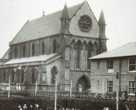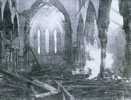 Nottingham Nottingham
St John the Baptist
History
The church of St John the Baptist, Leenside was located in probably the poorest part of the parish of St Mary the Virgin. It was opened in 1844 to provide additional places for worship within a parish which originally extended over two thousand acres, accommodating a rapidly expanding population. St John’s was located on the south-east side of the town close to the London Road one of the main routes into the town. Sited on flat meadow land below the high sandstone rock on which stood its mother church the two buildings were, in a straight line, only a few hundred metres apart, but from their churchyards neither could view the other.
Legislation in 1843 permitted the division of over-populated parishes in industrial towns and gave the Church Building Commissioners powers to raise £600,000 to help fund new Anglican churches. Whereas Archdeacon Wilkins of St Mary’s had refused to contemplate the division of St Mary’s, he was happy to promote new churches as chapels of ease within his parish because he would be able to influence their churchmanship and incumbency. His successor at St Mary’s, the Rev Joshua Brooks, had no such scruples, and the first new church in Nottingham was already being planned before the new rules were introduced: St John the Baptist, Leenside. This church was to serve the working-class areas on the south side of St Mary’s, an area ‘inhabited chiefly by people of the humbler rank of life’, according to the prospectus.
The foundation stone was laid on 9 August 1843 by Charles Pierrepont, second Earl Manvers.
A committee had been formed in 1841 under the chairmanship of the Rev W J Butler to plan the new building. Grants were available from a number of sources, although Butler complained to the Bishop of Lincoln that ‘the Church Building Acts are so confused and full of references to former acts in almost every one of them, that our Nottingham lawyers appear not to be able to give us satisfactory directions’. The committee estimated that it needed to raise £7050: of this £3000 was to build the church, £3000 to endow the clergyman, and £1050 to buy the land. The project was hampered by depression in the textile trades. Butler told the bishop in May 1842 ‘we make but little progress in getting subscriptions because the town and neighbourhood are in too greatly distressed a state to allow us to call personally on those who we think likely to subscribe.’
The Nottinghamshire Church Extension Society offered £500. The Incorporated Society for Promoting the Enlargement, Building and Repair of Churches and Chapels, a private and independent national church building society often loosely referred to as the Church Building Society offered a further £500. Another £800 came from the Church Building Commissioners. Many other donations were made by leading members of the local community, among them Manvers (£105), Thomas Adams, the lace entrepreneur with a warehouse in the adjacent Lace Market (£50), Francis Wright of Lenton (£1000), Dr Charles Storer, a physician at the Nottingham General Hospital (£50), and Archdeacon Wilkins (£50).
The grants were usually given with strings attached, particularly that they were made with the intention of supplying ‘church accommodation and pastoral care for the populous district situated on the south side of St Mary’s parish’. To this end all the pews were to be free, even though this created additional difficulties when it came to funding the clergy stipend.
By the end of July 1842 the committee had raised nearly £3000 but according to Butler
the very great distress of the town and district which has arisen since we commenced our endeavours to raise this church, and on which of course we did not and could not calculate, makes it very difficult for us to hope that we shall be able to raise the amount required for the endowment especially as we find such uphill work, as yet, to raise the little we have in this place.
Three months later it had all got too much for Butler who had been ordered by his doctor to rest due to ‘excessive application and anxiety of mind’.
Eight architects were invited to submit plans, and those of Sir George Gilbert Scott and William Bonython Moffatt were considered ‘the best’. The church took just 15 months to build, and it was dedicated on the 6 November 1844 by the Bishop of Lincoln, the Rt Rev John Kaye. It eventually cost £4000.
St John’s was one of the first churches in the town to offer all its seats free. By the mid 1850s the seats in the chancel, were however reserved for the use of the ‘fashionables’ the so called carriage trade, who although not residents of the parish were attracted by the quality of the preaching and St John’s adoption of the Anglican High Church style of worship. The choir were moved from the west gallery into the chancel about 1860. In 1856 the ‘papist’ practice of daily morning prayers was introduced.
The 1851 Religious Census records that on the Census Day the church was nearly full with 450 in the morning, plus 290 Sunday School scholars, 90 in the afternoon and 700 in the evening. Average figures were 500 at the morning service, 100 in the afternoon and 800 in the evening plus 250 scholars attending the afternoon Sunday School. The population of the Parish in 1851 was 5962. In 1841 it had been 4000. The same census also records four non-conformists churches within a few minutes walk of St John’s.
Along with the church building a National school was opened on a nearby site about 1850. It was reported well establish by inspectors in 1855. At some point the church also purchased a local public house, the Ten Bells, which was converted into a mission centre, and also used for entertainment and teaching, including adult education.
A new reredos was added in February 1871, and in 1880 two four-foot candlesticks were introduced inside the altar rail to provide more light.
In 1892 Sydney Race, a local diarist, described the church as ‘quite filled with fashionable people which is a good sign as the surroundings of the Church are very poor … the ceremonial was dignified and English and quite different from the Romish way of St Albans’.
In 1912 the extra parochial Church of St James Standard Hill was incorporated with St John’s. The two parishes did not share boundaries: in fact, St Nicholas’ on Castle Gate, and St Peter’s on Wheeler Gate were both closer. St James’ was regarded as broad or even low church which resulted in the vicar conducting early Sunday morning service at St James’ in their preferred style and then moving to St John’s to don vestments appropriate for High Church Mass.
The population increase slowed after 1860, although it exceeded 7,000 by 1881. At that time the housing conditions were already very poor and over the next thirty years they deteriorated to the point that demolition of the entire area was seen as the only option. Little progress was made due to the demands of the 1914-1918 war, but early in the 1920s large scale housing clearance began. The residents were moved to new housing on council estates around the outskirts of the city. By 1931 only two hundred houses remain within St John’s parish. About half of these were new council houses which are extant, forming the new thoroughfare of Cliff Road. The courts, alleys and yards which formed the 1884 parish had passed into history leaving St John’s with a very small congregation, the ‘fashionables’ long since also having moved to new pastures.
In 1930 St James’ was separated from St John’s and united with St Peter’s, and in 1934 St John’s was united with St George’s, Lauder Street, a church which shared the High Church tradition and was also served by the Kelham Fathers, who had supplied the priests to St John’s since the 1920s.
 The bombed-out The bombed-out
interior |
By August 1939 a proposal had been made to move St John’s ‘brick by brick’ to a new site on one of the outer city housing estates. An opposition group countered by reporting that the building was in a very poor state with crumbling masonry and brickwork. No action was taken. On the night 8th-9th May 1941 Nottingham was the target of a raid by the German airforce. St John’s, with many other buildings was destroyed by the high explosives and incendiary bombs that rained down on the city. In the morning light all that remained of the church was the still smouldering shell supported by perilously balanced pillars and empty window frames. Everything was lost.
Services for the congregation were transferred to St George’s.
When the site had been made safe a small area of the chancel was fitted with a temporary roof and a limited number of services were held. With the reduced population numbers of the parish and the preference of the City Council to redevelop the area for commercial use, the church of St John the Baptist Leenside was finally closed and demolished in 1946 ending its one hundred and two years of service.
| 


 The bombed-out
The bombed-out





